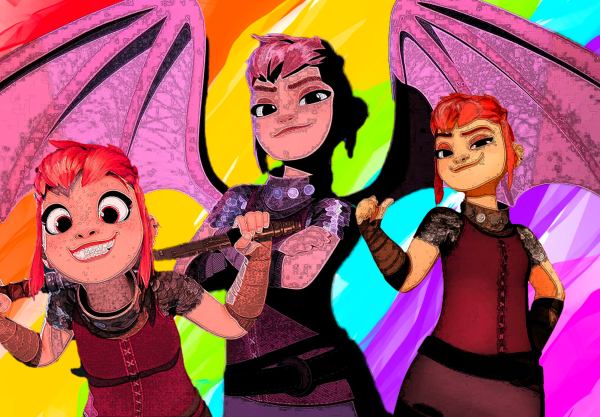In today’s era, when the push for broader representation in media is stronger than ever, “Nimona” shines brightly as a beacon of progress in the animated realm. This Netflix release not only breaks new ground with its heartwarming portrayal of queer love and identity, but also weaves a narrative that is as revolutionary as it is reflective of contemporary times.

“Nimona” is a film translation of N.D. Stevenson’s acclaimed webcomic and graphic novel to the screen, celebrated widely for its engaging storytelling, humor and inclusive portrayal of LGBTQ+ characters. The movie has received critical acclaim, as evidenced by its ratings — 7.5/10 on IMDB and 93% on Rotten Tomatoes — and its nomination for a 2024 Oscar. It premieres on June 14 at the Annecy International Animation Film Festival and begins streaming on Netflix June 30.
A GLANCE AT THE PLOT
Ballister is a brave young man destined to be a knight, but he becomes a wanted fugitive when his sword mysteriously kills the beloved queen during his initiation ceremony. Seeking to prove his innocence, Ballister teams up with Nimona, a spunky teen with shape-shifting abilities and together they go on the run. Ballister and Nimona embark on a quest to reveal the truth behind the queen’s death and expose the corruption within the kingdom. Their dangerous but thrilling adventure tests the limits of their abilities as they take on powerful knights in combat and unravel a sinister conspiracy.
QUEER LOVE IS NO LONGER A STRANGE THING
This film’s portrayal of queer love is unique. Ballister and his boyfriend Ambrosius are a queer couple, and the movie hints at their romantic relationship from the beginning. In the final scene, their kiss confirms the relationship.
Unlike other movies where queer love is only implied, such as “The Mitchells vs. The Machine,” or where the queer couple is not the center of the story, “Nimona” normalizes love between two men. Every character in “Nimona” appears to accept and normalize the queer couple and their relationship.
The relationship between Ballister and Ambrosius transcends the typical love story, offering viewers a glimpse into the complexities of queer love. Their journey, characterized by difficulties, atonement and unwavering loyalty, emphasizes that love knows no bounds.
THE INNOVATIVE PERSPECTIVES TOWARD TRANSGENDER IDENTITY
Nimona is portrayed as a rebellious, weird girl who used to be regarded as a monster because of her shape-shifting abilities. Her shape-shifting alludes to the transformation of gender and the confusion of societal rejections. Ironically, people accept the gay romance of Ballister and Ambrosius, but not her. Her character offers a powerful commentary on transgender identity confusion and social taboo, as well as rejections; she embodies resilience and the quest for acceptance. Significantly, Stevenson, the author of the comic and the co-producer of the movie, is nonbinary and transmasculine.
The film, therefore, is not merely about queer love and going against authority and prejudice toward “monsters,” but about the transgender experience, with all its confusion and social rejections.
WHAT NEXT?
The generally warm reception of “Nimona” sparks hope that we are entering a new era of representation in animation. By showcasing the journey of a genderfluid character in a queer romance, the film pushes boundaries and sets positive examples. Audiences crave these fresh narratives that reflect diverse experiences beyond the norm.
Projects like Disney’s mythical Colombian-inspired film, “Encanto,” seem poised to continue broadening the representation of marginalized communities. Mirabel’s protagonist offers a rare depiction of a disabled Disney character. And with Lin-Manuel Miranda involved, musical storytelling will further immerse viewers.
As “Nimona” sets new benchmarks, the question remains: what future projects will continue to push the boundaries of representation?


